Part 2 of a series
A tunnel of green arched overhead as we made our way along the wild and winding stretch of road leading toward the coast from the main highway. The tiny town finally emerged into view; it was the same precious village we’d seen from the sea when we went snorkeling. Like many of the towns along the Costalegre, there’s not a lot here, aside from a lineup of palapa-covered restaurants, a single hotel and a spectacular beach, enclosed by two imposing, granite outcroppings. But what more could a vacationer want?
We made our way down to the beach, passing five-gallon buckets filled with fresh oysters on a table with a big stone and a hammer – the main kitchen, apparently, for this restaurant. We set our things down in a weathered fishing boat and plunged into the waves, deliciously cool but not cold, playfully alive and a crystalline aquamarine – almost, but not quite, the only swimmers on this beach.
Heading back up we found a woman selling flower-shaped mangos on sticks and pineapples filled with cut fruit with a touch of curacao. A man approached us with a plateful of fresh shellfish – pata de mula, or mulefoot, he said it was called. He gave us a sample, cracking open a fresh one and garnishing it with lemon, salt and a bit of chili sauce. Delicious. I was sold. Meanwhile, Toni had negotiated a deal with the fruit seller and we sat down to a huge stuffed pineapple and a plate of shellfish before taking another dip and continuing along the coast.
Personally, I’m delighted to find that such places still exist.
Boca de Iguanas
The next stop up the coast is known as a surfer’s paradise. Unlike Cuastecomates, there is no town here and the beach is private, a trend we were to discover prevails along much of this coast. It is, however, pretty accessible for those willing to pay the cost of a campsite. When we arrived, a pair of bricklayers were spiffing up the grounds in preparation for the coming high season, remodeling a small concession building and café. We made our way past the freshly painted coconut palms to the beach, where we admired the scrabbling little hermit crabs and their criss-crossed trails, then found a little cave at the bottom of the cliff where a shrine had been placed to the Virgin of the Beach.
We found the incongruous virgin tucked inside the small grotto, gazing seaward in decidedly unbeachlike apparel, draped in scapulars and surrounded with assorted offerings: shells, pebbles, a feather. A couple had placed her in the cave, according to the resort caretaker, upon the occasion of their wedding some thirty years ago, and since that time, couples from all over the place had come here to wed. We paid our respects and climbed up to the top of a winding stone staircase to a spectacular overlook at the top of the bluff.
At the top of the bluff we found Coconuts by the Sea, a tiny four-room boutique hotel hideaway that is run by a couple of American expats. Charming and cozy, the retreat looks out on a spectacular view. We didn’t find the owners at home but we visited awhile with Alejandro, who takes care of the place while the owners are gone. We asked him what our next stop should be and he pondered the thought. It’s hard to say, he said, because everything from here on up is private, and you have to have a reservation to get in.
“Really? What about Tenacatita?” I asked, thinking of the Lonely Planet guidebook entry, which had made this bay sound really spectacular.
“Well, it used to be a great place to visit, but not anymore,” he said sadly.
Mentioned as one of the best beaches in the Lonely Planet guidebook, we were shocked to learn what had become of it. Once the home of various palapa-style restaurants like the ones we saw at Cuastecomates, a couple of small hotels and surf shops and a couple of boating guides who would take you on a bird and gator ride through the mangroves, the entire beach was purchased by a private investor who forced everyone to move and installed a chain-link fence across the highway. The owners sued and this spring, the courts ruled the beach was public property, and the beach is now open for swimming – but there are no facilities of any kind and the concessioners have not been allowed to return.
As he spoke, I remembered reading about the incident a couple of years ago, when state police came in to evict the business owners and destroy their little thatch-roofed restaurants. I remember an interview with a distraught woman whose family had owned this restaurant for two generations. So, this was the place.
We were saddened by the loss of livelihood for many, and the loss of a favorite seaside escape for many more. More selfishly, we were disappointed to have lost the chance at a sunset boat ride through the mangroves. I knew from experience that this can be a highlight to a trip to the coast, since it’s there that the most spectacular birds tend to congregate and make themselves seen. Alejandro gave this some thought.
It turned out that Alejandro had been one of those boating guides in Tenacatita. An American biologist had taken him under his wing and was teaching him bird identification; it was the dream job, and he thought he’d found his calling in life. Suddenly he found himself unemployed. One of his clients and friends was just opening up his new boutique hotel, Coconuts by the Sea, and upon learning of Alejandro’s dilemma, was able to bring him onboard. Alejandro is grateful for the job but dreams of the day he can go back to being a birding guide.
He still has friends in the business, though, and when he saw our interest, he quickly started making phone calls. Mangrove tours are still available in the neighboring resort, Los Angeles Locos, formerly known as Blue Bay, but you have to have a reservation, or a friend with a contact. Alejandro was able to get in touch with his friend and get us in to see the place, but he wasn’t available today. Still, it might be possible that someone with a boat could give us a tour, or that someone would loan us a boat and Alejandro could give us a tour. Having nothing better to do, we headed to Los Angeles Locos with Alejandro.
We arrived at what cinematographers like to call the Golden Hour – that magical moment when the sunlight strikes from the side – and an already magnificent place was lit up like a scene from a nautical fairytale. I took a walk along the coast, shooting to my heart’s content as the white pelicans and the great white herons posed and preened atop the dramatic, seaswept rocks and took in the sun. No boatride was forthcoming but we had a lovely walk and a lovely visit with Alejandro, who showed us the mangrove lagoon and shared with us some sea almonds we found along the way – surprisingly delicious.
One more tip from Alejandro – if you just want to go to Blue Bay for a tour through the mangroves, or if you just want to go down and spend time on this beautiful stretch of bay, the guards will let you in if you tell them you’re coming to eat at Restaurante La Vena.
The sun was setting as we made our way back out from the resort to the main highway on a road that circled the bay. We stopped the car to step out at an overlook and walked past an abandoned roadside restaurant, overgrown with weeds, to an old wooden deck. This restaurant probably dated back to the days when these were still public lands and when Mexican tourists could still afford to come here, I thought. The irony of the situation was palpable.
A sunflower the color of a blood orange, of the kind common in this area that I’d never seen before, sprung up through a broken board from the earth below the deck. The orange-red and fuchsia skies reflected in the constantly moving waves, and we bid our farewell to the sea before heading back south to Barra de Navidad, our home for one more night.
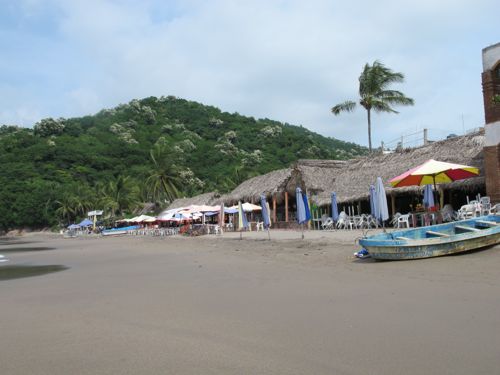


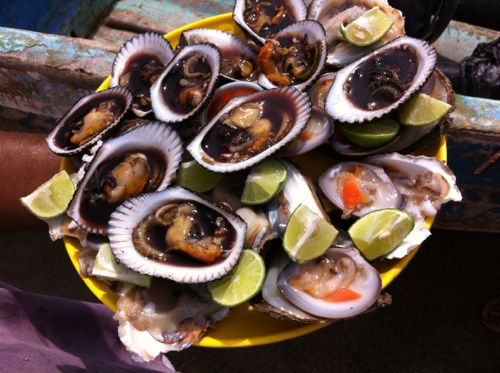
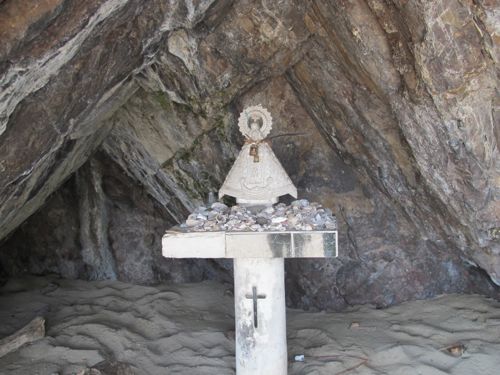
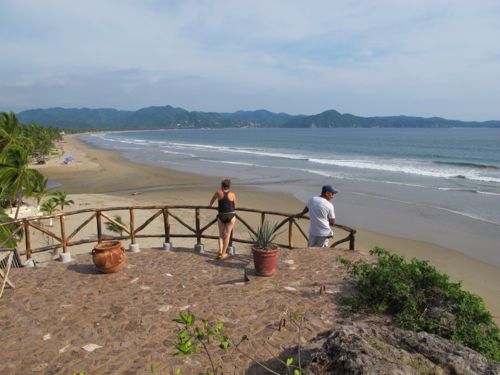
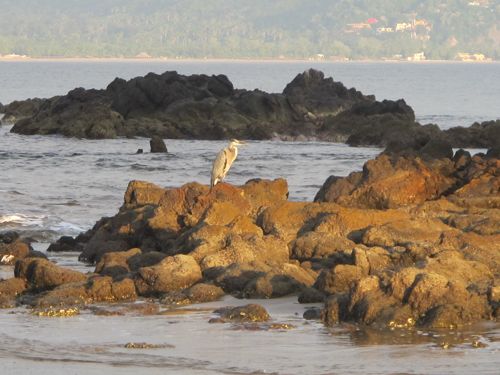
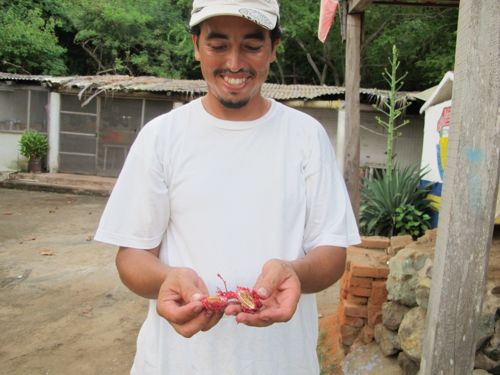


Leave a Reply